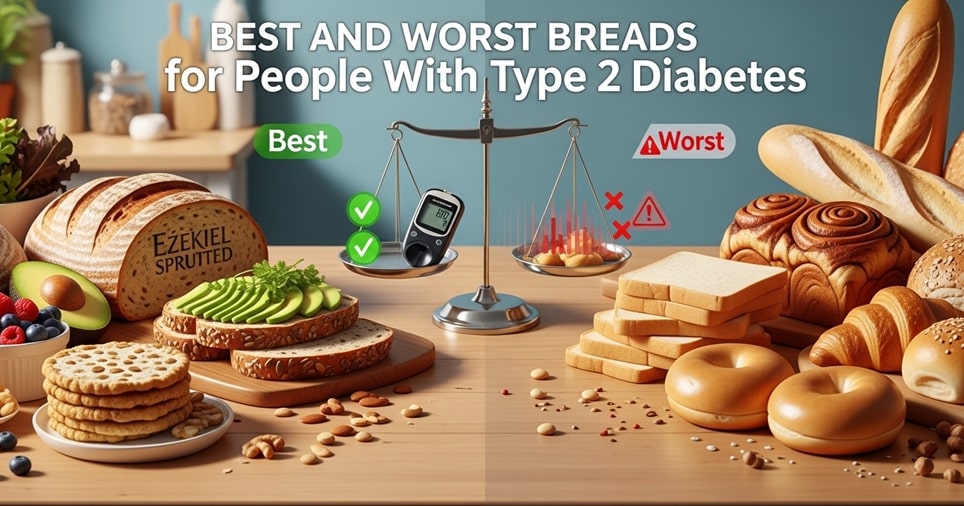
For individuals managing Type 2 Diabetes, navigating the world of carbohydrates can be a daily challenge. Bread, a staple in many diets, often becomes a food to avoid due to its potential to spike blood sugar levels. However, with a growing understanding of nutrition and the development of new food products, this is no longer necessarily the case. The key lies in selecting breads that are low in carbohydrates and have a low Glycemic Index (GI), which measures how quickly a food raises blood glucose. Making informed choices about the bread you consume can be a powerful tool in achieving stable blood sugar control and supporting overall health.
Understanding the Science: Carbs, GI, and Blood Sugar
To make empowered decisions, it’s crucial to understand the mechanisms at play. When you consume carbohydrates, your body breaks them down into glucose, which enters the bloodstream. For someone with Type 2 Diabetes, the body either resists the effects of insulin—the hormone that ushers glucose into cells—or doesn’t produce enough insulin to maintain normal glucose levels. This is where the type and quality of carbohydrates become paramount.
Net Carbohydrates: The Figure That Matters Most
While total carbohydrates are important, net carbohydrates are often considered a more accurate gauge of a food’s impact on blood sugar for those on a low-carb diet. This figure is calculated by subtracting dietary fiber and sugar alcohols (if applicable) from the total carbohydrates. Fiber is a type of carbohydrate that the body cannot digest, meaning it passes through the system without raising blood glucose levels. Therefore, a bread high in fiber will have a lower net carb count and a gentler effect on your blood sugar.
The Glycemic Index (GI) and Glycemic Load (GL)
The Glycemic Index (GI) is a ranking system for carbohydrates on a scale from 0 to 100, indicating how quickly they raise blood glucose levels. Low-GI foods (55 or less) are digested and absorbed more slowly, leading to a gradual rise in blood sugar. High-GI foods (70 and above) cause a rapid spike. The Glycemic Load (GL) takes this a step further by considering the GI and the portion size, providing a more complete picture of a food’s real-world impact. A bread might have a moderate GI, but if you eat a large portion, the glycemic load can still be high. The goal is to find breads that are both low in net carbs and have a low GI/GL.
Key Ingredients to Look For in Diabetes-Friendly Breads
The ingredient list is your most valuable resource when shopping for suitable bread. Move beyond the marketing on the front of the package and scrutinize what’s inside. Breads that support blood sugar management are typically made with whole, nutrient-dense ingredients and are high in fiber and protein.
- Whole Grains and Sprouted Grains: Sprouted grain breads, such as those made from sprouted wheat, barley, and millet, undergo a process that breaks down starch, which can result in a lower GI compared to bread made from regular whole wheat flour. The sprouting process also increases certain nutrients and may improve digestibility.
- High-Fiber Flours: Look for breads that use flours naturally high in fiber and low in digestible carbs. Excellent options include almond flour, coconut flour, flaxseed meal, and chia seed flour. These are not only low in net carbs but also provide healthy fats and protein.
- Seed and Nut Blends: Many of the best low-carb breads are packed with a variety of seeds like sunflower, pumpkin, flax, and sesame. These add crunch, flavor, fiber, healthy fats, and essential minerals, contributing to satiety and stable energy levels.
- Wheat Gluten (Vital Wheat Gluten): Often used in low-carb baking, vital wheat gluten is the protein portion of wheat. It provides structure and a bread-like texture without the high carbohydrate content of regular flour. It is generally well-tolerated, but individuals with celiac disease or a gluten sensitivity must avoid it.
- Psyllium Husk: This is a form of soluble fiber that is a miracle worker in gluten-free and low-carb baking. It absorbs water and forms a gel, which helps bind ingredients together and creates a moist, elastic texture that closely mimics traditional bread.
Top Choices for Low-Carb and Low GI Breads
Based on nutritional profiles and ingredient quality, several types of bread stand out as excellent choices for a diabetes management plan. It is always essential to compare specific brands, as recipes can vary significantly.
1. Sprouted Grain Bread
Brands like Ezekiel 4:9 are popular examples of sprouted grain bread. These breads are made from organic, sprouted whole grains and legumes, which increases their nutrient availability and lowers their glycemic impact. They are typically high in fiber and protein, making them a sustaining choice. A single slice usually contains a moderate amount of carbohydrates, but the high fiber content results in a favorable net carb count and a low GI.
2. 100% Whole Rye Bread (Pumpernickel)
Authentic, dense, sourdough rye bread, such as traditional pumpernickel, is a stellar option. Rye has a naturally lower GI than wheat, and the sourdough fermentation process further helps to reduce the bread’s glycemic response. The beneficial bacteria and yeasts in the sourdough starter pre-digest some of the starches, and the resulting organic acids can slow down digestion. Look for heavy, dense loaves with a short ingredient list, primarily whole rye flour.
3. Low-Carb, High-Fiber Commercial Breads
The market has responded to consumer demand with several commercial brands specifically formulated to be low in net carbohydrates. Brands such as Sola, Aunt Millie’s, and certain varieties from Schmidt Old Tyme are engineered with high-fiber ingredients like resistant wheat starch, which acts similarly to fiber in the body. These breads often have a taste and texture very close to traditional white or wheat bread, making them an easy switch, but always verify the net carbs and ingredient list.
4. Flaxseed and Almond Flour Bread
For those following a very low-carb or ketogenic diet, breads made primarily from almond flour and flaxseed are ideal. You can find these in the freezer section of health food stores or easily make them at home. Almond flour is low in carbs, high in healthy fats and protein, and has a minimal impact on blood sugar. Flaxseed is an excellent source of fiber and omega-3 fatty acids. Together, they create a dense, moist, and nutty bread that is highly satisfying.
5. Cloud Bread (Oopsie Bread)
While not a traditional bread, cloud bread has become a popular low-carb alternative. It is made primarily from eggs, cream cheese, and a small amount of cream of tartar. It is virtually free of carbohydrates, making it an excellent choice for minimizing blood sugar impact. Its texture is light and airy, similar to a cream puff, and it works well as a base for sandwiches or toast. However, it lacks the fiber of other options on this list.
Ingredients to Consistently Avoid
Just as important as knowing what to look for is knowing what to steer clear of. Certain ingredients are red flags that indicate a bread will likely cause a significant blood sugar spike and offer little nutritional value.
- Refined Flours: The most common ingredient to avoid is enriched wheat flour or white flour. This flour has been stripped of its bran and germ, removing most of its fiber, vitamins, and minerals. What remains is mostly starch, which the body converts to glucose very rapidly.
- Added Sugars: Be vigilant for added sugars, which can appear under many names including high-fructose corn syrup, honey, molasses, cane sugar, brown rice syrup, and dextrose. Even breads that seem savory can contain surprising amounts of added sugar to enhance flavor and browning.
- Artificial Additives: While not directly affecting blood sugar, a clean ingredient list is generally preferable for overall health. Avoid breads with long lists of preservatives, artificial flavors, and emulsifiers you don’t recognize.
Conclusion: Integrating Bread into a Healthy Diabetic Diet
Successfully managing Type 2 Diabetes does not require giving up bread entirely. Instead, it necessitates a shift toward smarter, more informed choices. By prioritizing breads that are rich in dietary fiber, made from whole food ingredients like sprouted grains, almond flour, and flaxseed, and low in net carbohydrates, you can enjoy this dietary staple without compromising your blood sugar goals. The most effective approach is to become an avid label reader, focusing on the net carb count and ingredient quality over marketing claims. Pairing a sensible portion of these healthier bread options with a source of protein and healthy fat, such as avocado or eggs, can further mitigate any blood sugar response and promote long-lasting satiety. Empowered with this knowledge, you can confidently navigate the bakery aisle as part of a balanced and sustainable diabetes management plan.










